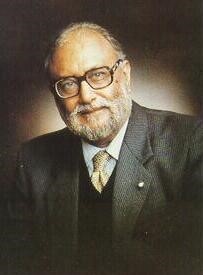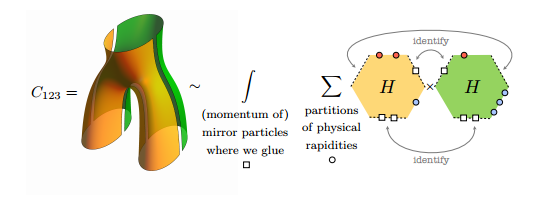Archive for June, 2015
A little bit of history: Abdus Salam and the creation of ICTP

A research institute that promotes basic science in developing countries. Today this is one of the main features of ICTP and ICTP-SAIFR. However, just over 50 years ago, this was just a dream that Pakistani physicist Abdus Salam had.
“The notion of a Centre that should cater particularly to the needs of physicists from developing countries had lived with me from 1954, when I was forced to leave my own country because I realised that if I stayed there much longer, I would have to leave physics, through sheer intellectual isolation”, he once said (Ideals and Realities 3rd ed., World Scientific, 392, 1989).

Abdus Salam’s first visit to Trieste, in 1960, for a Symposium on Elementary Particle Interactions
The history of ICTP began in 1960. This was the year Salam became professor of theoretical physics at Imperial College, where, together with Paul Matthews, he created a research group in this area. Also in 1960, Salam, as a delegate from Pakistan, proposed to the IAEA (International Atomic Energy Agency) the creation of an international center for theoretical physics.
Salam’s proposal was discussed and became a reality four years later. In 1964, the ICTP was founded in Trieste, Italy, and Salam became its director. At that time, due to the Cold War, Europe lived a great separation between the east and the west. Therefore, since its creation, ICTP became a rare line of communication between different countries.

ICTP’s first Scientific Council, in1964, chaired by Robert Oppenheimer
Over the next 50 years, ICTP maintained the ideal of its main creator. The Centre continued to bring together scientists from around the world and to promote basic science especially in developing countries. With the financial support of the Italian government, the IAEA and agencies such as UNESCO, the institute has helped more than 140,000 scientists to participate in conferences, workshops, courses and other events.
In 2010, ICTP, in collaboration with Universidade Estadual Paulista “Julio de Mesquita Filho” (Unesp) and with Fundação de Amparo à Pesquisa do Estado de São Paulo (FAPESP) created a new center, located in South America – the ICTP-SAIFR. The goal remains the same: to promote basic research at the highest international level, but this time with a special focus on South American countries.

Abdus Salam was awarded the Nobel prize in 1979, jointly with Steven Weinberg and Sheldon Glashow, for their contributions to the theory of the unified weak and electromagnetic interaction between elementary particles, including, inter alia, the prediction of the weak neutral current
Continue Reading | Comments Off on A little bit of history: Abdus Salam and the creation of ICTP
Um pouco de história: Abdus Salam e a criação do ICTP

Um instituto de pesquisa que promove a ciência básica em países em desenvolvimento. Hoje o ICTP, assim como o ICTP-SAIFR, tem essa como uma de suas principais características. Porém, há pouco mais de 50 anos atrás, esse era apenas um sonho do físico paquistanês Abdus Salam.
“A noção de um Centro que atenda particularmente às necessidades dos físicos de países em desenvolvimento viveu comigo desde 1954, quando fui forçado a deixar o meu próprio país porque percebi que se ficasse muito mais tempo por lá eu teria de deixar a Física, devido puramente ao isolamento intelectual”, disse ele uma vez. (Ideals and Realities 3rd ed., World Scientific, 392, 1989).

Primeira visita de Abdus Salam à Trieste, em 1960, para um simpósio sobre interação de partículas elementares
A história do ICTP começou em 1960. Nesse ano, Salam se tornou professor de Física Teórica no Imperial College onde, junto com Paul Matthews, criou um grupo de pesquisa nessa área. Ainda em 1960, Salam, como representante do Paquistão, propôs ao IAEA (International Atomic Energy Agency) a criação de um centro internacional de Física Teórica.
A proposta de Salam foi discutida e se tornou uma realidade quatro anos depois. Em 1964, o ICTP foi fundado em Trieste, na Itália, e Salam se tornou seu diretor. Devido à Guerra Fria, a Europa vivia naquela época uma grande separação entre países do leste e do oeste do continente. Portanto, desde a sua criação, o ICTP se tornou uma rara ponte de comunicação entre diferentes países.

Primeiro Conselho Científico do ICTP, em 1964, presidido por Robert Oppenheimer
Ao longo dos 50 anos seguintes, o ICTP manteve o ideal de seu principal criador. O Centro continuou a reunir cientistas do mundo inteiro e a promover a ciência básica principalmente em países em desenvolvimento. Com o suporte financeiro do governo italiano, da IAEA e de agências como a UNESCO, o instituto já ajudou mais de 140 mil cientistas a participarem de conferências, workshops, cursos e outros eventos.
Em 2010, o ICTP, em colaboração com a Universidade Estadual Paulista “Júlio de Mesquita Filho” (Unesp) e com a Fundação de Amparo à Pesquisa do Estado de São Paulo (FAPESP) criou um novo centro, localizado na América do Sul – o ICTP-SAIFR. O objetivo continua o mesmo: promover a pesquisa básica no mais alto nível internacional, mas dessa vez com enfoque especial nos países sul-americanos.

Abdus Salam foi laureado com o prêmio Nobel em 1979, junto com Steven Weinberg e Sheldon Glashow, por suas contribuições à teoria de unificação entre as interações fraca e eletromagnética entre partículas elementares, incluindo a previsão da corrente neutra fraca
Continue Reading | Comments Off on Um pouco de história: Abdus Salam e a criação do ICTP
Studying interactions in String Theory
Work based on ideas that emerged during the ICTP-SAIFR partnership with the Perimeter Institute provides a new way to look at how strings interact with one another
Between the months of November 2014 and February 2015, the ICTP-SAIFR made a partnership with the Perimeter Institute, of Canada, to study topics related to Field Theory. During this period, the collaboration promoted the exchange of researchers and students between the institutes. Three months after the end of the partnership, Benjamin Basso, Shota Komatsu and Pedro Vieira, published an article based on ideas that emerged throughout their time in ICTP-SAIFR.
“We had the ideas and started discussing them while we were in Brazil,” says Basso. “We immediately saw potential in these ideas, so we developed them and tested their veracity and predictions.”
Their work is in the field of String Theory – more specifically on its duality with strongly coupled Quantum Field Theories. According to the theory, strings are fundamental elements and their vibrations are related to the mass and energy of the particles that they form. The study of Basso and his colleagues provides a new way to look at how the strings interact, and to what happens when one of these strings is broken into two or when two strings join to form one.
“When trying to solve a complex problem in physics, we often try to break it into smaller and simpler problems”, explains Basso. “This is what we did in our work. Instead of studying a complex problem that involves an object in the form of a pair of pants, we cut this object in two hexagons. With these more elementary geometric shapes, we made the problem simpler both conceptually and technically; we could explicitly solve for these hexagons using the integrability of the theory”.
Click here to read the article.
The next step of the work will be to verify that the model remains valid after the hexagons are “glued” together again, recreating the original structure in the form of a pair of pants.
“We know that our description works well when the two halves are separated, but we don’t know if everything will continue to be fine after the union of the halves,” says Basso. “We are optimistic and will continue to polish the picture to verify this. If the model proves to be correct, we will have a better understanding of the elementary string interactions of this theory”.
Continue Reading | Comments Off on Studying interactions in String Theory
Estudando interações na Teoria das Cordas
Trabalho que se originou durante parceria do ICTP-SAIFR com o Perimeter Institute propõe nova forma de olhar para os fenômenos de interação entre cordas
Entre os meses de novembro de 2014 e fevereiro de 2015, o ICTP-SAIFR realizou uma parceria com o Perimeter Institute, do Canadá, para estudar temas relacionados a Teoria de Campos. Durante esse período, a colaboração promoveu o intercâmbio de pesquisadores e alunos entre os institutos. Três meses após o final da parceria, Benjamin Basso, Shota Komatsu e Pedro Vieira, publicaram um artigo baseado em ideias que surgiram ao longo de sua estada no ICTP-SAIFR.
“Tivemos as ideias e começamos a discuti-las enquanto estávamos no Brasil”, diz Basso. “Nós vimos, de imediato, potencial nessas ideias, então as desenvolvemos e testamos suas previsões”.
O trabalho dos pesquisadores está relacionado à Teoria das Cordas – mais especificamente em sua dualidade com acoplamentos fortes na Teoria Quântica de Campos. De acordo com a teoria, as cordas são elementos fundamentais e suas vibrações estão relacionadas com a energia e massa das partículas que formam. O estudo de Basso e seus colegas fornece uma nova maneira de olhar para o modo como as cordas interagem entre si, e para o que acontece quando uma dessas cordas se quebra em duas ou quando duas cordas se unem.
“Muitas vezes em Física, para tentar resolver um grande problema, tentamos quebrá-lo em problemas menores e mais simples”, explica Basso. “Foi isso que fizemos nesse trabalho. Em vez de estudar um problema complexo, que envolve um objeto no formato de um par de calças, cortamos esse objeto em dois hexágonos. Com essas formas geométricas mais elementares, tornamos o problema mais simples tanto conceitualmente como tecnicamente; nós conseguimos resolver, explicitamente, os problemas relacionados aos hexágonos usando a integrabilidade da teoria”.
Leia o artigo clicando aqui.
O próximo passo do trabalho será verificar se o modelo se mantém válido após os hexágonos serem “colados” novamente, recriando a estrutura original no formato do par de calças.
“Sabemos que nossa descrição funciona quando as duas metades estão separadas, mas ainda não podemos afirmar que ela continuará válida após a união das metades em uma só forma”, diz Basso. “Estamos otimistas e vamos continuar polindo essas figuras para fazer a verificação. Caso o modelo se mostre correto, conseguiremos entender melhor as interações entre os elementos fundamentais da Teoria das Cordas”.
Continue Reading | Comments Off on Estudando interações na Teoria das Cordas
